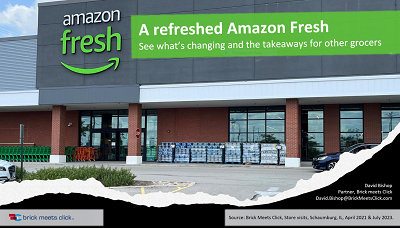Aldi's integrated ad/promotion: What every grocery retailer should know
Complete the form below to instantly download this month's dashboard.
Aldi has developed a powerful integrated ad/promotional program that makes it easier for their customers to see how they can do more of their grocery and related shopping at Aldi. To do this, Aldi must encourage customers to buy more of its own label, which means overcoming lack of familiarity, so this shift takes time and effort.
Below are the three key features of Aldi’s approach –print circulars, online marketing content, and in-store features that support the program – that every grocery retailer should appreciate.
How Aldi promotes "differentli"
1. Printed Circulars
Aldi offers two weekly printed circulars in the store at any time. The first lists the current week’s specials and a cross section of ALDI Finds (seasonal deals and home goods that are available for only a short period of time). The second – the "ALDI Insider" – previews upcoming sale items so customers can plan ahead.
THE WEEKLY AD. The current week sales circular features “hot” prices on meat and produce on its front page. This is where Aldi makes its strongest price impression. In the remaining pages, most of the food and general merchandise items are themed by special event, holiday, or meal idea. Check out the subtle way that Aldi merchandises the items required to prepare the three meals identified on the page below – Pan Seared Tilapia, Chicken Alfredo Penne, and Easy Shrimp Caesar Salad.

THE ALDI INSIDER invitescustomers to “Come back next week for these limited time ALDI Finds!” The layout issimilar to the weekly sales circular but the main focus is on general and seasonal merchandise items with some meat,dairy, and grocery items featured – the only thing missing is produce.

By offering the "ALDI Insider" preview, Aldi is building on the idea of helping customers plan more than a week into the future, and grouping the products by theme telegraphs what’s being offered over a longer period of time. For example:
- Superbowl and Valentine’s Day the products started appearing in January weekly ads and Insiders.
- The Valentine’s Day items that appeared in January ads offered three plush toys at significantly different price points – $0.99, $3.99, and $12.99 – which provided broad appeal.
This preview strategy gives Aldi the time and space to promote more items under each theme, which generates greater sales and higher overall gross profit.
2. Online Promotion

Aldi’s online ad/promotion is more extensive than its print ads and includes a lot of content marketing explaining the quality and value of its brands and new products. For example, here is the chart that compares Aldi’s Little Journeys diapers to national brands. The message to customers (and other retailers too) is that Aldi is delivering better value for its private label than many retailers are offering with the CPG brands. (For example, the hypoallergenic liner with vitamin E.)
While Aldi’s online communications probably reach only a fraction of the shoppers who pick up the weekly circular, the online ad/promotion expands the program for those who visit the website and/or are connected to Aldi via email, social media, etc.

3. In-store Signage and Programs
Aldi continues to invest in signage and programs that support the ads/promotional program:
- New in-store signs draw attention to weekly specials and price drops that highlight savings.
- In-store signs also promote Aldi’s long-standing“Twice as Nice” Guarantee, which offers to refund and replace Aldi-brand items that were bought but weren’t satisfactory.

BMC POV
Aldi’s success at driving changes in shopping behavior will not only grow the share of private label spending by its customers, it will do so at the expense of nationally advertised brands.
This emphasis is apparent in the head-to-head TV ads in which Aldi encourages customers to compare its own products with comparable nationally advertised brands. Aldi also seems to follow an annualized cadence for investing in TV advertising, one that allows them to spend on mass media primarily in weeks where they have the biggest potential to drive incremental sales.
Aldi’s approach will also likely prompt other retailers to use digital communications, and possibly print, to alert their shoppers about what they can expect the retailer to offer in the future.
Retailers who are (or will be)competing with hard discounters should do three key things before they rethink and adjust their competitive strategy.
- Determine the share of their customers who are likely to be attracted to the hard discounter.
- Go to the Aldi website with an open mind (leave defensiveness aside) to see and learn from what they’re doing.
- Ask their wholesalers for help in generating more sales, not necessarily just income.
Thanks to Bill Bolton for contributing his observations to this Lookout.












